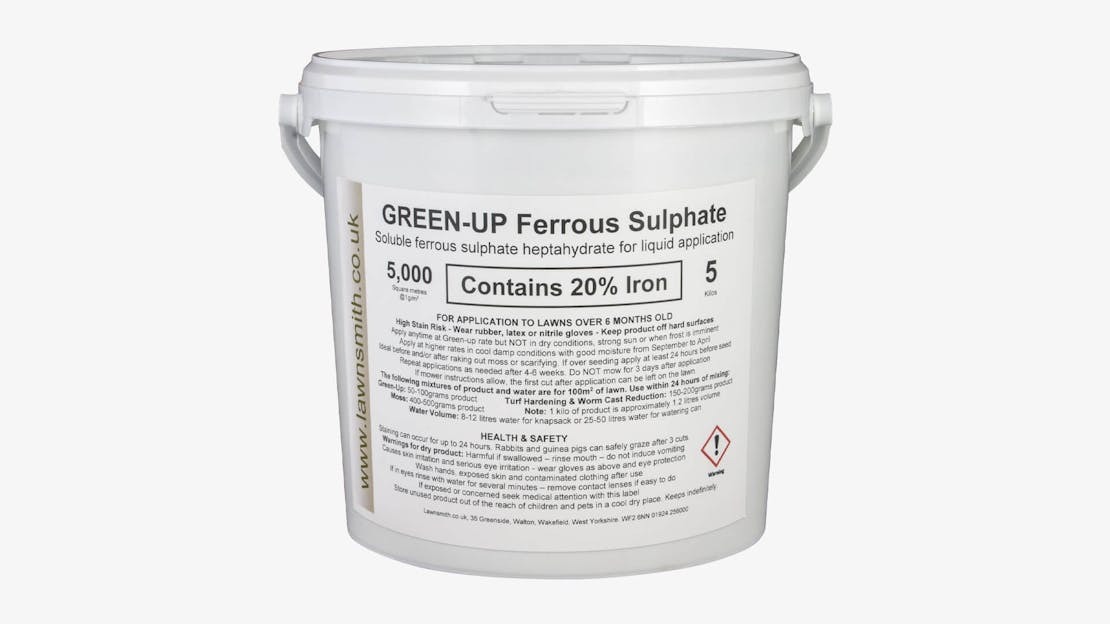
Using Ferrous Sulphate
Ferrous Sulphate is great for grass. From greening in the summer to protecting in the winter and killing moss in spring it's the perfect lawn treatment.
I love soluble iron. Also known as iron sulphate, ferrous sulphate and sulphate of iron, it gives a wonderful green up without extra mowing. It also helps keep the grass healthy throughout the cooler months.
Iron Sulphate for a Grass Green Up
As a ‘green-up’ for turf Lawnsmith® Ferrous Sulphate would be mixed with water at the rate of 50 to 150 grams to treat 100 square metres of lawn. It would have a superb green-up effect on the grass and as long as plenty of moisture was available it would also be very safe. This means you can use iron sulphate at these concentrations pretty much any time of year as long as good soil moisture is available and there is no strong sun or heat.
Iron Sulphate for Hardening & Disease Resistance
Increase the concentration to 150 to 200 grams and not only will it have a good green-up effect but it will also start to ‘harden’ the turf making it more resistant to disease and fungal attack. This is a very common practice on sports turf in late autumn and winter. At this concentration blackening of the moss will start to occur and unless conditions are on the cool side with ground moisture available it may cause some slight but temporary damage to the grass as well. I suggest you only consider applying between September and April when plenty of moisture is available and there is no likelihood of strong sunshine.
Iron Sulphate will Blacken Moss
Were you to do a repeat application (double dose) at the turf hardening rate or just increase the concentration to 400 to 500 grams not only will it green the grass and harden the turf but you will severely blacken moss. If you apply at this rate ensure cool wet conditions to aid penetration into the moss and reduce any possibility of temporary damage to the grass. The maximum safe limit for Lawnsmith® Ferrous Sulphate is 500 grams per 100 square metres in at least 5 and preferably 10 litres of water. This strength is perfectly safe for the grass in cool wet conditions.
Mixing Iron Sulphate
Iron sulphate dissolves quite readily. As you will generally be mixing in the cooler months I suggest adding a little warm water to speed the dissolving process. Once mixed use it the same day as the iron will start to oxidise thereby losing its efficacy. It won’t work very well either!! If you’re using a watering can to apply to the lawn use a Weed & Feed Sprinkle Bar for even application otherwise a knapsack sprayer is the best bet. As with all soluble products (like salt) it can be difficult to dissolve the last grain, therefore, I suggest following the procedure below to prevent clogging of the holes in sprinkle bars or spray nozzles or watch the video in the ‘Spraying Fertiliser playlist’
- Wear rubber or nitrile gloves to prevent staining to hands
- For ease of weighing you can treat 1 kilo equal to 1.2 litres volume
- Mix in a different container to the one used to apply the product
- Mixing with tepid water will help dissolve the product more quickly
- Thoroughly stir until most has dissolved
- Allow to stand for a minute
- Now pour your mixture into your watering can or sprayer leaving the last cupful of dregs in the bottom of the bucket
- This cupful contains the particles that didn’t dissolve and may cause clogging
- If you need to mix more than one lot then keep the dregs as some will dissolve with the next mixing